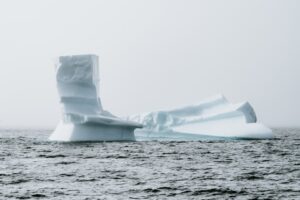Physical Address
23,24,25 & 26, 2nd Floor, Software Technology Park India, Opp: Garware Stadium,MIDC, Chikalthana, Aurangabad, Maharashtra – 431001 India
Physical Address
23,24,25 & 26, 2nd Floor, Software Technology Park India, Opp: Garware Stadium,MIDC, Chikalthana, Aurangabad, Maharashtra – 431001 India

Arctic sea ice, a critical component of Earth’s climate system, is on the brink of witnessing its first-ever ice-free day before 2030. As highlighted in a study leveraging advanced CMIP6 climate models, this pivotal transition is not a distant possibility but a looming reality. The researchers’ focus on daily projections has uncovered that internal climate variability, rather than emissions scenarios alone, could drive this dramatic event. Rapid ice loss events during late summer are key triggers with profound implications for ecosystems, weather patterns, and climate feedback systems, underscoring the urgent need for global climate action.
Accelerated Sea Ice Decline and Timing Predictions
Arctic sea ice has been shrinking for decades, a clear signal of the intensifying impacts of anthropogenic climate change. Previous studies estimated that an entirely ice-free Arctic during summer could occur by 2050. A recent study in Nature Communications shows this threshold could arrive far earlier. The potential for an ice-free Arctic by 2030 is not a distant possibility but a stark reality. Using projections aligned with 2023 sea ice levels, researchers identified instances where ice-free days occurred in as little as three years in high-variability scenarios, regardless of emissions pathways.
The projection was derived using daily data from multiple models in the Coupled Model Intercomparison Project Phase 6 (CMIP6). Researchers Céline Heuzé of the University of Gothenburg and Alexandra Jahn from the University of Colorado Boulder stated that “there is a non-zero probability of an ice-free day before 2030”.
The first ice-free day could materialise well before 2030, even under moderate emissions scenarios. The likelihood of avoiding this milestone grows slimmer, particularly in a warmer Arctic where climate systems amplify the effects of heatwaves and storms. Once an ice-free day occurs, the phenomenon is unlikely to remain isolated, paving the way for more extended periods of open water in subsequent years.
Cascading Consequences for Ecosystems and Climate Systems
Transitioning from a white, reflective Arctic Ocean to a predominantly blue one during summer will have far-reaching consequences. As ice diminishes, it exposes darker ocean waters, which absorb more solar heat, accelerating regional warming—a process known as the ice-albedo feedback loop. This additional heating could exacerbate ice loss throughout the year and heighten global climate variability.
Ecosystems dependent on stable ice cover, from polar bears to microscopic zooplankton, are poised to face unprecedented challenges. As sea ice serves as a platform and habitat for many Arctic species, its disappearance could ripple through food chains and biodiversity. Additionally, mid-latitude regions may see more extreme weather events due to disrupted Arctic air currents and warming-induced shifts in jet stream patterns.
Critical Role of Internal Variability and Future Outlooks
Internal climate variability plays a significant role in the timing of ice-free conditions. Rapid Ice Loss Events (RILEs)—periods marked by abrupt reductions in sea ice—serve as pivotal moments in the models, driven by warmer winters, spring heatwaves, and intensifying storms. These events have been observed sporadically and are expected to increase in frequency as global temperatures rise.
Despite the grim outlook, the study emphasises the critical need to limit global warming to below 1.5°C, which aligns with the Paris Agreement’s goal. Scenarios that achieve this target show delayed or potentially avoided ice-free days, highlighting the crucial role of international climate action. While uncertainties persist due to variability and model differences, the findings clearly warn about the Arctic’s imminent transformation, making the Paris Agreement target more significant than ever.
While the first ice-free day in the Arctic is a highly symbolic milestone, it does not mean that the Arctic Ocean will remain ice-free annually from that point onward. This event is not expected to trigger immediate or dramatic changes but marks a crucial step in progressing long-term climate trends. “But it will show that we’ve fundamentally altered one of the defining characteristics of the natural environment in the Arctic Ocean, which is that it is covered by sea ice and snow year-round through greenhouse gas emissions,” said Alexandra Jahn.
The study highlighted the pressing need for global action to combat climate change, showing that the Arctic is quickly approaching a point where ice-free conditions will become a reality. As the world approaches this symbolic and impactful threshold, it becomes increasingly clear that Arctic resilience hinges on swift and decisive action. This action could include reducing greenhouse gas emissions, transitioning to renewable energy sources, and implementing sustainable land use practices.
References:
https://www.nature.com/articles/s41467-024-54508-3
Banner image:
Photo by Annie Spratt on Unsplash